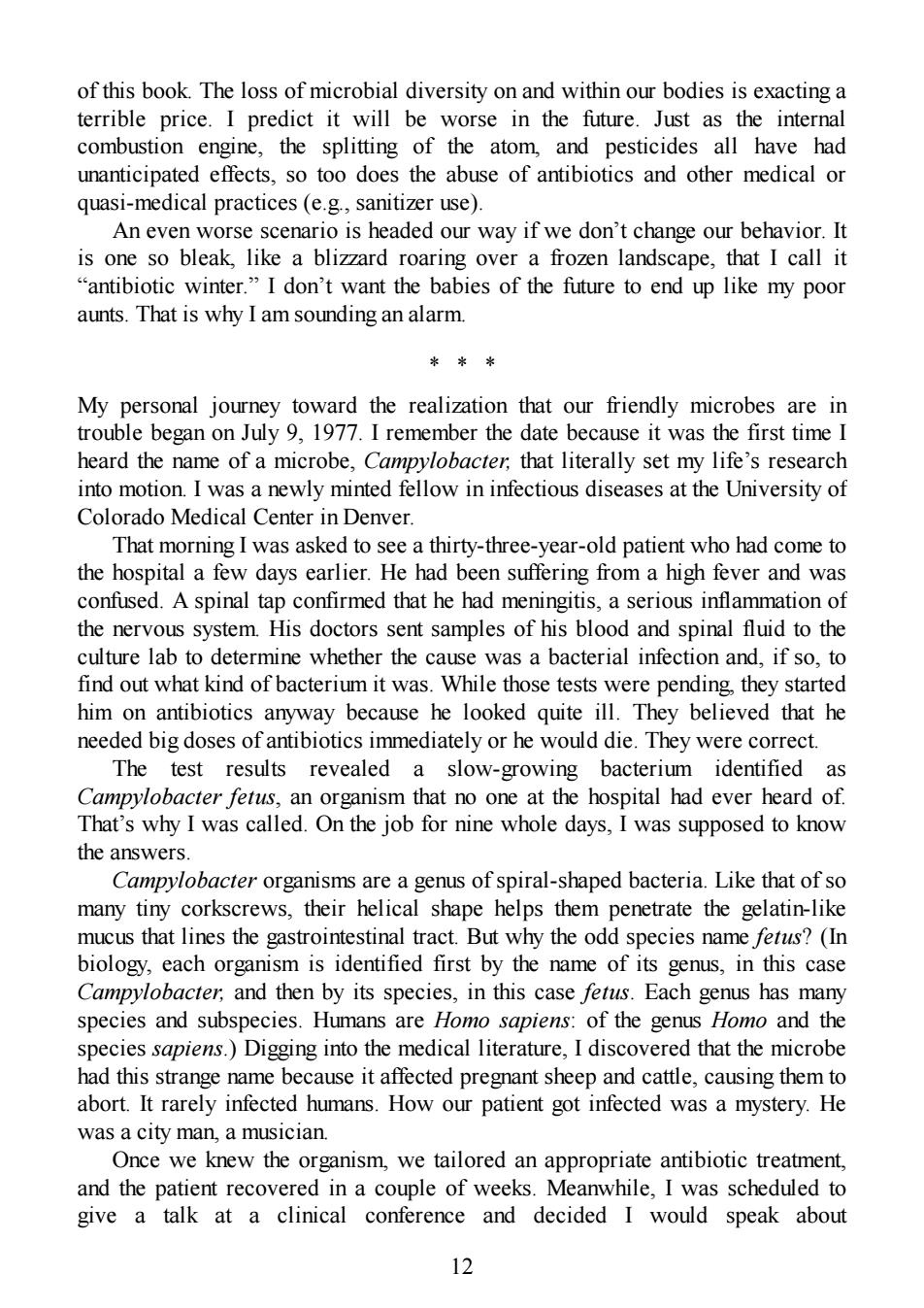正在加载图片...

of this book.The loss of microbial diversity on and within our bodies is exacting a terrible price.I predict it will be worse in the future.Just as the internal combustion engine,the splitting of the atom,and pesticides all have had unanticipated effects,so too does the abuse of antibiotics and other medical or quasi-medical practices (e.g,sanitizer use). An even worse scenario is headed our way if we don't change our behavior.It is one so bleak,like a blizzard roaring over a frozen landscape,that I call it "antibiotic winter."I don't want the babies of the future to end up like my poor aunts.That is why I am sounding an alarm. My personal journey toward the realization that our friendly microbes are in trouble began on July 9,1977.I remember the date because it was the first time I heard the name of a microbe,Campylobacter.that literally set my life's research into motion.I was a newly minted fellow in infectious diseases at the University of Colorado Medical Center in Denver. That morning I was asked to see a thirty-three-year-old patient who had come to the hospital a few days earlier.He had been suffering from a high fever and was confused.A spinal tap confirmed that he had meningitis,a serious inflammation of the nervous system.His doctors sent samples of his blood and spinal fluid to the culture lab to determine whether the cause was a bacterial infection and,if so,to find out what kind of bacterium it was.While those tests were pending,they started him on antibiotics anyway because he looked quite ill.They believed that he needed big doses of antibiotics immediately or he would die.They were correct. The test results revealed a slow-growing bacterium identified as Campylobacter fetus,an organism that no one at the hospital had ever heard of. That's why I was called.On the job for nine whole days,I was supposed to know the answers Campylobacter organisms are a genus of spiral-shaped bacteria.Like that of so many tiny corkscrews,their helical shape helps them penetrate the gelatin-like mucus that lines the gastrointestinal tract.But why the odd species name fetus?(In biology,each organism is identified first by the name of its genus,in this case Campylobacter,and then by its species,in this case fetus.Each genus has many species and subspecies.Humans are Homo sapiens:of the genus Homo and the species sapiens.)Digging into the medical literature,I discovered that the microbe had this strange name because it affected pregnant sheep and cattle,causing them to abort.It rarely infected humans.How our patient got infected was a mystery.He was a city man,a musician. Once we knew the organism,we tailored an appropriate antibiotic treatment, and the patient recovered in a couple of weeks.Meanwhile.I was scheduled to give a talk at a clinical conference and decided I would speak about 12of this book. The loss of microbial diversity on and within our bodies is exacting a terrible price. I predict it will be worse in the future. Just as the internal combustion engine, the splitting of the atom, and pesticides all have had unanticipated effects, so too does the abuse of antibiotics and other medical or quasi-medical practices (e.g., sanitizer use). An even worse scenario is headed our way if we don’t change our behavior. It is one so bleak, like a blizzard roaring over a frozen landscape, that I call it “antibiotic winter.” I don’t want the babies of the future to end up like my poor aunts. That is why I am sounding an alarm. * * * My personal journey toward the realization that our friendly microbes are in trouble began on July 9, 1977. I remember the date because it was the first time I heard the name of a microbe, Campylobacter, that literally set my life’s research into motion. I was a newly minted fellow in infectious diseases at the University of Colorado Medical Center in Denver. That morning I was asked to see a thirty-three-year-old patient who had come to the hospital a few days earlier. He had been suffering from a high fever and was confused. A spinal tap confirmed that he had meningitis, a serious inflammation of the nervous system. His doctors sent samples of his blood and spinal fluid to the culture lab to determine whether the cause was a bacterial infection and, if so, to find out what kind of bacterium it was. While those tests were pending, they started him on antibiotics anyway because he looked quite ill. They believed that he needed big doses of antibiotics immediately or he would die. They were correct. The test results revealed a slow-growing bacterium identified as Campylobacter fetus, an organism that no one at the hospital had ever heard of. That’s why I was called. On the job for nine whole days, I was supposed to know the answers. Campylobacter organisms are a genus of spiral-shaped bacteria. Like that of so many tiny corkscrews, their helical shape helps them penetrate the gelatin-like mucus that lines the gastrointestinal tract. But why the odd species name fetus? (In biology, each organism is identified first by the name of its genus, in this case Campylobacter, and then by its species, in this case fetus. Each genus has many species and subspecies. Humans are Homo sapiens: of the genus Homo and the species sapiens.) Digging into the medical literature, I discovered that the microbe had this strange name because it affected pregnant sheep and cattle, causing them to abort. It rarely infected humans. How our patient got infected was a mystery. He was a city man, a musician. Once we knew the organism, we tailored an appropriate antibiotic treatment, and the patient recovered in a couple of weeks. Meanwhile, I was scheduled to give a talk at a clinical conference and decided I would speak about 12